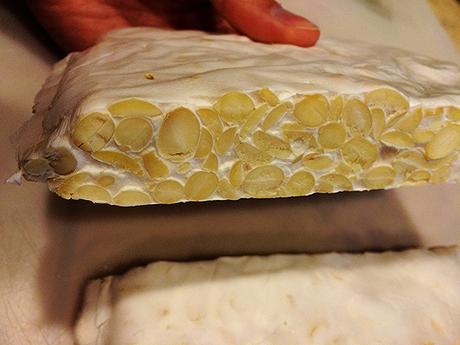
I’m a big fan of anything fermented (check out my post on how to make kimchi!), so I was super excited to try making my own tempeh. I lucked out and found a package of starter from Cultures for Health at my local co-op. I’ve had a lot of success in the past with their kombucha and vegan yogurt starters.
There are are few caveats that I should get out of the way before preceding. Making your own tempeh isn’t going to save you money. Tempeh is pretty inexpensive and is readily available in many grocery store. Making tempeh is also going to take some time and effort. The fermentation process alone takes 2 days and that’s not including the preparation time. What you will get is a fresh, delicious homemade product that will taste better than anything you buy in the store. In my opinion, that alone is worth the effort.
So let’s get to it!
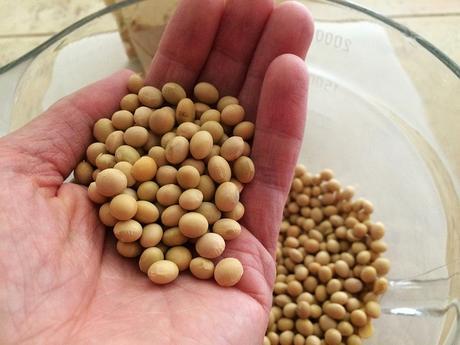
All of the equipment and ingredients are listed in the recipe below. The list doesn’t need to be exact; these are just the items that I ended up using. Do your best and make do with what you have on hand in your own kitchen.
Start by soaking 2 pounds (about 2-1/2 cups) of soy beans in a large bowl over night or for at least 12 hours. The beans will expand so make sure to cover them with enough water that they remain submerged.
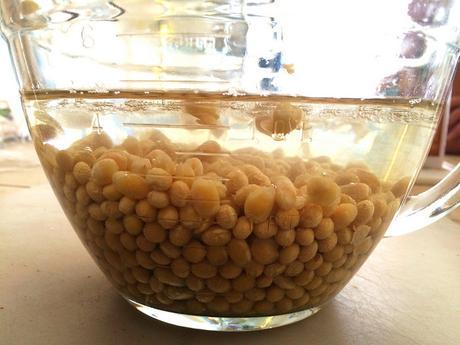
The next step is probably the most labor intensive. The beans need to be split and de-hulled. Use your hands, a potato masher, rolling pin, or what have you to smash the beans and remove the skins. If you just happen to have a grain mill laying around the house, give that a try as it might save you a lot of time. I used a combination of hands and rolling pin. I had some success with soaking the beans in water, squeezing, letting the hulls float to the top, and then draining them off. Don’t worry about getting every last hull removed.
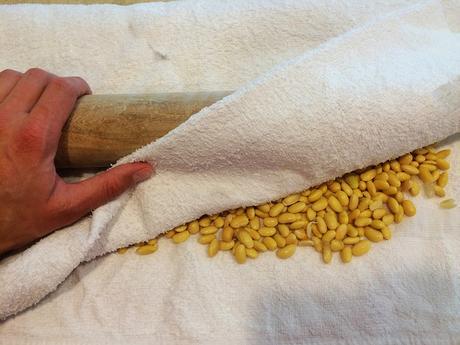
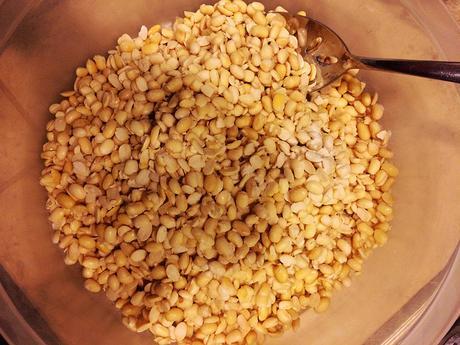
Move your beans to a large pot with fresh water and bring to a boil. Lower heat and simmer for about 45 minutes or until the beans become tender. Remove any hulls that float to the top. Prepare 2-quart sized zip lock bags by puncturing holes throughout with a needle or skewer. I placed my holes in 1-inch intervals. This allows the beans to breath during the fermentation process.
Drain the beans and spread them out on 2 towel lined baking sheets. Pat them dry and allow to cool completely. Transfer into a clean bowl and mix in vinegar. The vinegar will lower the pH of the beans and inhibit the grown of unwanted bacteria. Sprinkle the tempeh starter onto the beans and make sure to thoroughly incorporate.
Evenly distribute the beans between the 2 bags and seal closed. They should be about 1-1 1/2 inch thick when laid flat. Now decided on the method of incubation. I’m using a TSM harvest food dehydrator because it has a temperature control. Other incubator possibilities might include the oven or a yogurt maker. Whatever your method, the tempeh needs to be kept between 85° and 90°F for the next 48 hours.
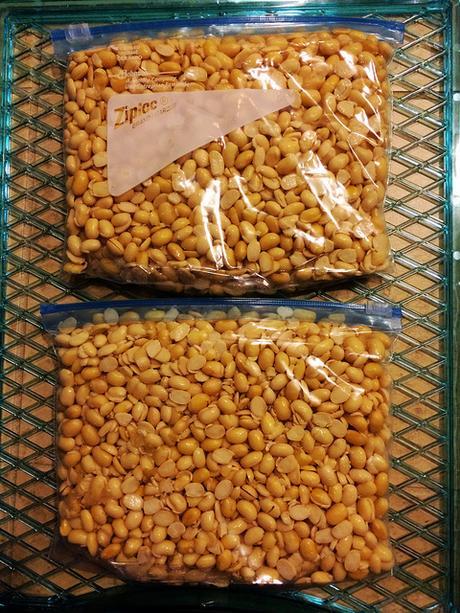
Check the temperature after 12 hours. The fermentation process will cause the beans to generate their own heat, so it might be necessary to turn off the external heat source. Since my dehydrator regulates the temperature, I’ve leave it on without any problems. The white mycelium should start growing between 12 and 24 hours. After 24 hours my beans were completely encased in the mycelium, binding the beans into a solid cake. A light nutty aroma will also become more apparent.
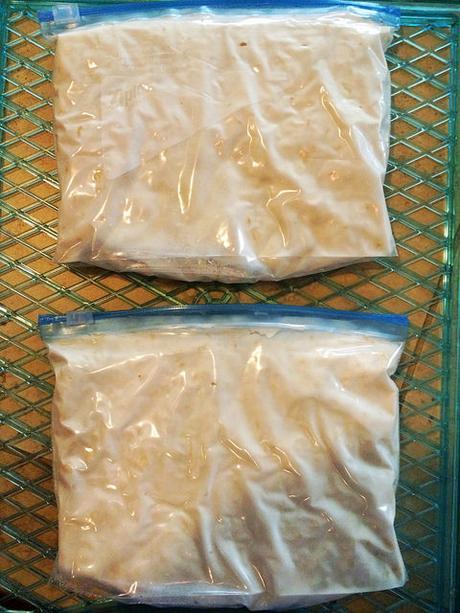
At this point, remove the tempeh from the dehydrator and refrigerate until ready to use. I’ve found that sometimes my store bought tempeh will have a slightly bitter taste; I didn’t notice this at all with the homemade tempeh. It was slightly softer than store bought but I figured this was do to it being freshly made. In the next couple of posts I’ll follow up with some of my favorite tempeh recipes. Enjoy!
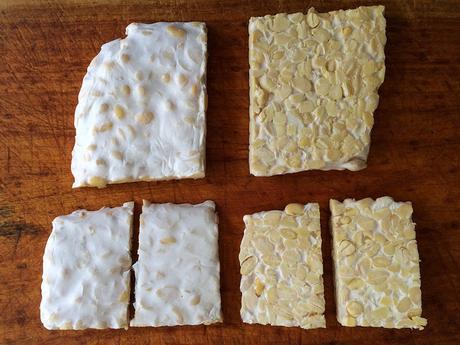
- 1 pound ( about 2 1/2 cups) soy beans
- 2 tablespoons vinegar
- 1 packet tempeh starter
- 2 large bowls
- Colander
- Large pot
- 2 baking sheets
- Measuring spoons
- Spatula or mixing spoons
- 2 quart-sized ziplock bags
- Skewer or large needle
- Towel (optional)
- Thermometer (optional - depending on incubation method)
- Dehydrator
- 1. Place beans in a large bowl and cover with enough water that they stay submerged as they begin to rehydrate. Let beans soak over night.
- 2. Remove the hulls and split the beans by squeezing or smashing with a potato smasher or rolling pin. I used a combination of both and found that wrapping the beans in a towel and running the rolling pin over them worked well. This is by far the most labor-intensive step. Split and de-hull as many beans as you can but don't worry about getting every last beans.
- 3. Move beans into a large pot with fresh water. Bring to a boil then reduce heat and simmer for 45 minutes or until beans become tender. Periodically skim the top for any remaining hulls.
- 4. While the beans simmer, prepare the ziplock bags by using a needle or skewer to puncture holes in 1-inch intervals throughout the bags.
- 5. Remove cooked beans from the pot and drain. Spread them out onto a towel or 2 cookie sheets and let cool completely.
- 6. Transfer the beans into a clean bowl, add vinegar, and mix. The vinegar will lower the pH of the beans and help inhibit the growth of unwanted bacteria. Sprinkle on the tempeh starter and mix thoroughly.
- 7. Evenly distribute the beans between the 2 bags and flatten to a thickness of 1 to 1-1/2 inch before sealing.
- 8. Place bags in dehydrator and maintain temperature at 85°F to 90°F for the next 48 hours. Check the temperature of the bags after 12 hours. The fermentation process will cause the beans to generate their own heat and require turning off the dehydrator.
- 9. The white mycellium will start to cover the beans after 24 hours and will completely incase and bind the beans together into a solid cake by 48 hours. The tempeh should have a pleasant nutty aroma.
- 10. Remove from dehydrator and refrigerate.
- *unused tempeh can be frozen by steaming for 20 minutes and storing in an airtight container in the freezer.
